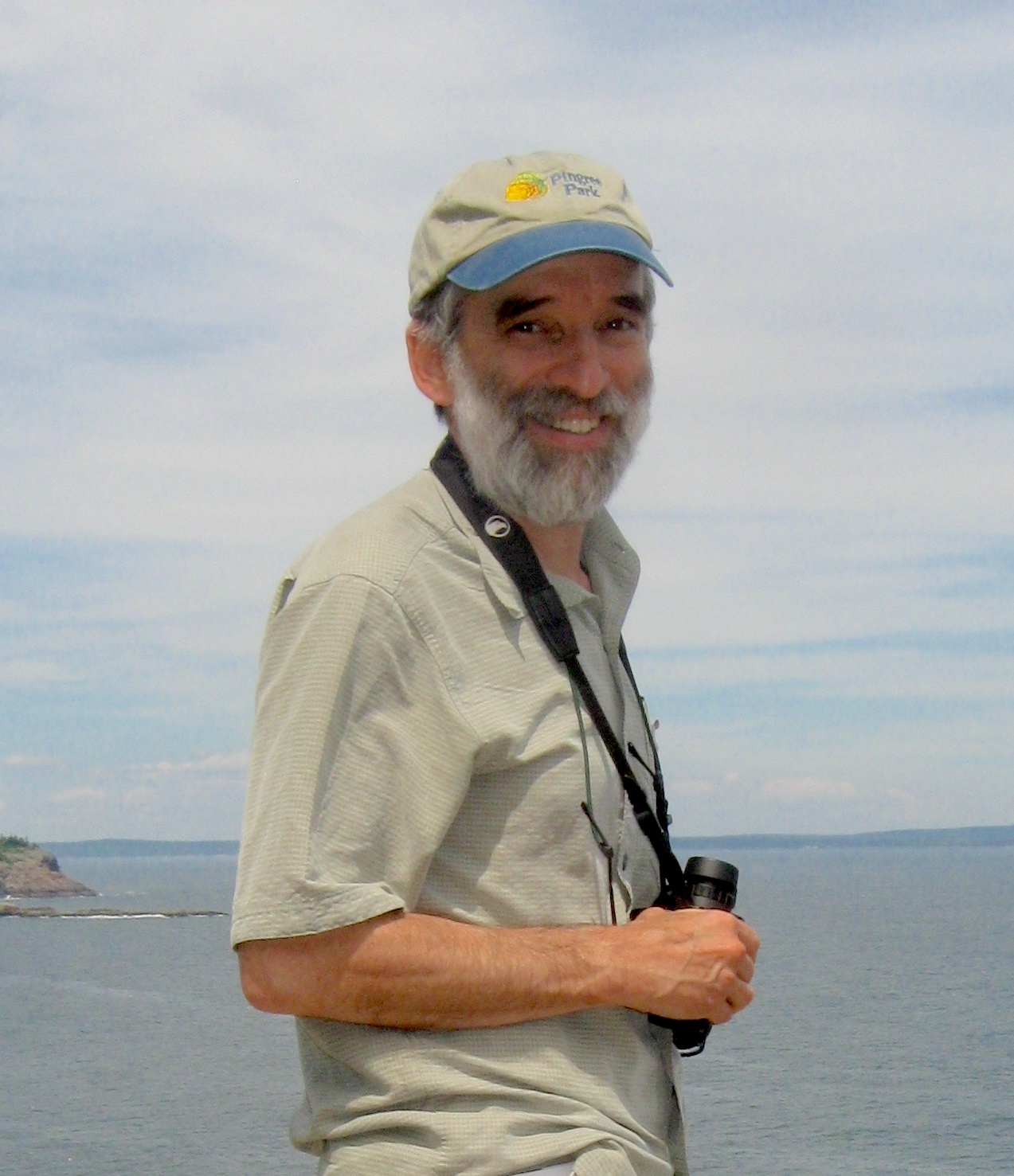Russ Charif My principal role in the K. Lisa Yang Center for Conservation Bioacoustics in recent years has been in scientific capacity building, primarily developing and leading our Sound Analysis Workshop (SAW). SAW trains research biologists and conservation practitioners in basic principles and methods of bioacoustics. These principles and methods are useful both for passive acoustic monitoring (PAM) of wildlife populations, and for investigating the behavioral ecology and evolution of acoustically active species.
My capacity building work builds on many years of experience with planning, data analysis, synthesis, and reporting for numerous PAM projects focusing primarily on large cetaceans and birds. I have also consulted with the Yang Center’s software developers about use cases and analysis needs of bioacoustics practitioners, and have contributed to the interface design of our software. I am the primary author of the Raven Pro User’s Manual . My principal scientific interests are in the behavioral ecology and evolution of acoustic signals.
Year Hired : 1992
Contact Information r.charif@cornell.edu
Degree(s) :
2394371
Charif
1
harvard1
50
date
desc
year
Charif
7990
https://www.birds.cornell.edu/ccb/wp-content/plugins/zotpress/
%7B%22status%22%3A%22success%22%2C%22updateneeded%22%3Afalse%2C%22instance%22%3Afalse%2C%22meta%22%3A%7B%22request_last%22%3A0%2C%22request_next%22%3A0%2C%22used_cache%22%3Atrue%7D%2C%22data%22%3A%5B%7B%22key%22%3A%22JKY4SPWI%22%2C%22library%22%3A%7B%22id%22%3A2394371%7D%2C%22meta%22%3A%7B%22creatorSummary%22%3A%22Clink%20et%20al.%22%2C%22parsedDate%22%3A%222024-03-01%22%2C%22numChildren%22%3A1%7D%2C%22bib%22%3A%22%26lt%3Bdiv%20class%3D%26quot%3Bcsl-bib-body%26quot%3B%20style%3D%26quot%3Bline-height%3A%201.35%3B%20%26quot%3B%26gt%3B%5Cn%20%20%26lt%3Bdiv%20class%3D%26quot%3Bcsl-entry%26quot%3B%26gt%3BClink%2C%20D.J.%20%26lt%3Bi%26gt%3Bet%20al.%26lt%3B%5C%2Fi%26gt%3B%20%282024%29%20%26%23x2018%3BA%20primer%20on%20terrestrial%20passive%20acoustic%20monitoring%20data%20management%3A%20Best%20practices%20and%20guidelines%26%23x2019%3B%2C%20%26lt%3Bi%26gt%3BThe%20Journal%20of%20the%20Acoustical%20Society%20of%20America%26lt%3B%5C%2Fi%26gt%3B%2C%20155%283_Supplement%29%2C%20pp.%20A94%26%23x2013%3BA95.%20Available%20at%3A%20%26lt%3Ba%20class%3D%26%23039%3Bzp-ItemURL%26%23039%3B%20href%3D%26%23039%3Bhttps%3A%5C%2F%5C%2Fdoi.org%5C%2F10.1121%5C%2F10.0026927%26%23039%3B%26gt%3Bhttps%3A%5C%2F%5C%2Fdoi.org%5C%2F10.1121%5C%2F10.0026927%26lt%3B%5C%2Fa%26gt%3B.%26lt%3B%5C%2Fdiv%26gt%3B%5Cn%26lt%3B%5C%2Fdiv%26gt%3B%22%2C%22data%22%3A%7B%22itemType%22%3A%22journalArticle%22%2C%22title%22%3A%22A%20primer%20on%20terrestrial%20passive%20acoustic%20monitoring%20data%20management%3A%20Best%20practices%20and%20guidelines%22%2C%22creators%22%3A%5B%7B%22creatorType%22%3A%22author%22%2C%22firstName%22%3A%22Dena%20J.%22%2C%22lastName%22%3A%22Clink%22%7D%2C%7B%22creatorType%22%3A%22author%22%2C%22firstName%22%3A%22Chris%22%2C%22lastName%22%3A%22Pelkie%22%7D%2C%7B%22creatorType%22%3A%22author%22%2C%22firstName%22%3A%22Russell%20A.%22%2C%22lastName%22%3A%22Charif%22%7D%2C%7B%22creatorType%22%3A%22author%22%2C%22firstName%22%3A%22Holger%22%2C%22lastName%22%3A%22Klinck%22%7D%5D%2C%22abstractNote%22%3A%22Recent%20advances%20in%20recording%20technology%20and%20data%20storage%20capabilities%20have%20revolutionized%20how%20we%20monitor%20vocal%20animals%20and%20their%20habitats.%20Recently%2C%20there%20has%20been%20an%20explosion%20of%20interest%20in%20the%20use%20of%20terrestrial%20passive%20acoustic%20monitoring%20%28PAM%29%20which%20relies%20on%20autonomous%20acoustic%20recording%20units%20%28ARU%29%2C%20but%20terrestrial%20PAM%20studies%20are%20limited%20by%20a%20lack%20of%20standardized%20protocols%20for%20data%20collection%2C%20analysis%2C%20and%20archiving.%20Here%2C%20we%20draw%20on%20collective%20experiences%20of%20recording%2C%20analyzing%2C%20and%20archiving%2C%20hundreds%20of%20years%20of%20PAM%20data%20to%20provide%20guidelines%20and%20recommendations%20for%20PAM%20practitioners.%20First%2C%20we%20highlight%20some%20of%20the%20major%20pitfalls%20in%20field%20data%20collection%2C%20including%20inappropriate%20recording%20settings%20for%20the%20research%20question%20and%20incomplete%20metadata.%20We%20then%20provide%20recommendations%20for%20data%20management%2C%20including%20suggestions%20for%20backing%20up%2C%20compressing%2C%20and%20archiving%20the%20data.%20Our%20goal%20is%20to%20provide%20the%20community%20with%20standardized%20working%20guidelines%20that%20will%20help%20facilitate%20comparative%2C%20large-scale%20terrestrial%20studies%20using%20PAM.%22%2C%22date%22%3A%222024-03-01%22%2C%22language%22%3A%22%22%2C%22DOI%22%3A%2210.1121%5C%2F10.0026927%22%2C%22ISSN%22%3A%220001-4966%22%2C%22url%22%3A%22https%3A%5C%2F%5C%2Fdoi.org%5C%2F10.1121%5C%2F10.0026927%22%2C%22collections%22%3A%5B%5D%2C%22dateModified%22%3A%222025-04-24T20%3A34%3A21Z%22%7D%7D%2C%7B%22key%22%3A%222L52HN96%22%2C%22library%22%3A%7B%22id%22%3A2394371%7D%2C%22meta%22%3A%7B%22creatorSummary%22%3A%22Arvind%20et%20al.%22%2C%22parsedDate%22%3A%222022-06-29%22%2C%22numChildren%22%3A2%7D%2C%22bib%22%3A%22%26lt%3Bdiv%20class%3D%26quot%3Bcsl-bib-body%26quot%3B%20style%3D%26quot%3Bline-height%3A%201.35%3B%20%26quot%3B%26gt%3B%5Cn%20%20%26lt%3Bdiv%20class%3D%26quot%3Bcsl-entry%26quot%3B%26gt%3BArvind%2C%20C.%20%26lt%3Bi%26gt%3Bet%20al.%26lt%3B%5C%2Fi%26gt%3B%20%282022%29%20%26%23x2018%3BSpecies%20detection%20framework%20using%20automated%20recording%20units%3A%20a%20case%20study%20of%20the%20Critically%20Endangered%20Jerdon%26%23x2019%3Bs%20courser%26%23x2019%3B%2C%20%26lt%3Bi%26gt%3BOryx%26lt%3B%5C%2Fi%26gt%3B%2C%20pp.%201%26%23x2013%3B8.%20Available%20at%3A%20%26lt%3Ba%20class%3D%26%23039%3Bzp-DOIURL%26%23039%3B%20href%3D%26%23039%3Bhttps%3A%5C%2F%5C%2Fdoi.org%5C%2F10.1017%5C%2FS0030605321000995%26%23039%3B%26gt%3Bhttps%3A%5C%2F%5C%2Fdoi.org%5C%2F10.1017%5C%2FS0030605321000995%26lt%3B%5C%2Fa%26gt%3B.%26lt%3B%5C%2Fdiv%26gt%3B%5Cn%26lt%3B%5C%2Fdiv%26gt%3B%22%2C%22data%22%3A%7B%22itemType%22%3A%22journalArticle%22%2C%22title%22%3A%22Species%20detection%20framework%20using%20automated%20recording%20units%3A%20a%20case%20study%20of%20the%20Critically%20Endangered%20Jerdon%27s%20courser%22%2C%22creators%22%3A%5B%7B%22creatorType%22%3A%22author%22%2C%22firstName%22%3A%22Chiti%22%2C%22lastName%22%3A%22Arvind%22%7D%2C%7B%22creatorType%22%3A%22author%22%2C%22firstName%22%3A%22Viral%22%2C%22lastName%22%3A%22Joshi%22%7D%2C%7B%22creatorType%22%3A%22author%22%2C%22firstName%22%3A%22Russell%22%2C%22lastName%22%3A%22Charif%22%7D%2C%7B%22creatorType%22%3A%22author%22%2C%22firstName%22%3A%22Panchapakesan%22%2C%22lastName%22%3A%22Jeganathan%22%7D%2C%7B%22creatorType%22%3A%22author%22%2C%22firstName%22%3A%22V.%20V.%22%2C%22lastName%22%3A%22Robin%22%7D%5D%2C%22abstractNote%22%3A%22With%20the%20advent%20of%20automated%20recording%20units%2C%20bioacoustic%20monitoring%20has%20become%20a%20popular%20tool%20for%20the%20collection%20of%20long-term%20data%20across%20extensive%20landscapes.%20Such%20methods%20involve%20two%20main%20components%3A%20hardware%20for%20audio%20data%20acquisition%20and%20software%20for%20analysis.%20In%20the%20acoustic%20monitoring%20of%20threatened%20species%2C%20a%20species-specific%20framework%20is%20often%20essential.%20Jerdon%26%23039%3Bs%20courser%20Rhinoptilus%20bitorquatus%20is%20a%20Critically%20Endangered%20nocturnal%20bird%20endemic%20to%20a%20small%20region%20of%20the%20Eastern%20Ghats%20of%20India%2C%20last%20reported%20in%202008.%20Here%20we%20describe%20a%20reproducible%20and%20scalable%20acoustic%20detection%20framework%20for%20the%20species%2C%20comparing%20several%20commonly%20available%20hardware%20and%20detection%20methods%20and%20using%20existing%20software.%20We%20tested%20this%20protocol%20by%20collecting%2024%2C349%20h%20of%20data%20during%205%20months.%20We%20analysed%20the%20data%20with%20two%20commercially%20available%20sound%20analysis%20programmes%2C%20following%20an%20analysis%20pipeline%20created%20for%20this%20species.%20Although%20we%20did%20not%20detect%20vocalizations%20of%20Jerdon%26%23039%3Bs%20courser%2C%20this%20study%20provides%20a%20framework%20using%20a%20combination%20of%20hardware%20and%20software%20for%20future%20research%20that%20other%20conservation%20practitioners%20can%20implement.%20Vocal%20mimicry%20can%20aid%20or%20confound%20in%20detection%20and%20we%20highlight%20the%20potential%20role%20of%20mimicry%20in%20the%20detection%20of%20such%20threatened%20species.%20This%20species-specific%20acoustic%20detection%20framework%20can%20be%20scaled%20and%20tailored%20to%20monitor%20other%20species.%22%2C%22date%22%3A%222022%5C%2F06%5C%2F29%22%2C%22language%22%3A%22en%22%2C%22DOI%22%3A%2210.1017%5C%2FS0030605321000995%22%2C%22ISSN%22%3A%220030-6053%2C%201365-3008%22%2C%22url%22%3A%22https%3A%5C%2F%5C%2Fwww.cambridge.org%5C%2Fcore%5C%2Fjournals%5C%2Foryx%5C%2Farticle%5C%2Fspecies-detection-framework-using-automated-recording-units-a-case-study-of-the-critically-endangered-jerdons-courser%5C%2FE6E7221E36C3DB88396099FFD82A2911%22%2C%22collections%22%3A%5B%22IMWW9QTW%22%5D%2C%22dateModified%22%3A%222022-06-30T17%3A26%3A36Z%22%7D%7D%2C%7B%22key%22%3A%222HR6F865%22%2C%22library%22%3A%7B%22id%22%3A2394371%7D%2C%22meta%22%3A%7B%22creatorSummary%22%3A%22Odom%20et%20al.%22%2C%22parsedDate%22%3A%222021-03-02%22%2C%22numChildren%22%3A0%7D%2C%22bib%22%3A%22%26lt%3Bdiv%20class%3D%26quot%3Bcsl-bib-body%26quot%3B%20style%3D%26quot%3Bline-height%3A%201.35%3B%20%26quot%3B%26gt%3B%5Cn%20%20%26lt%3Bdiv%20class%3D%26quot%3Bcsl-entry%26quot%3B%26gt%3BOdom%2C%20K.J.%20%26lt%3Bi%26gt%3Bet%20al.%26lt%3B%5C%2Fi%26gt%3B%20%282021%29%20%26%23x2018%3BComparative%20bioacoustics%3A%20a%20roadmap%20for%20quantifying%20and%20comparing%20animal%20sounds%20across%20diverse%20taxa%26%23x2019%3B%2C%20%26lt%3Bi%26gt%3BBiological%20Reviews%26lt%3B%5C%2Fi%26gt%3B%20%5BPreprint%5D.%20Available%20at%3A%20%26lt%3Ba%20class%3D%26%23039%3Bzp-DOIURL%26%23039%3B%20href%3D%26%23039%3Bhttps%3A%5C%2F%5C%2Fdoi.org%5C%2F10.1111%5C%2Fbrv.12695%26%23039%3B%26gt%3Bhttps%3A%5C%2F%5C%2Fdoi.org%5C%2F10.1111%5C%2Fbrv.12695%26lt%3B%5C%2Fa%26gt%3B.%26lt%3B%5C%2Fdiv%26gt%3B%5Cn%26lt%3B%5C%2Fdiv%26gt%3B%22%2C%22data%22%3A%7B%22itemType%22%3A%22journalArticle%22%2C%22title%22%3A%22Comparative%20bioacoustics%3A%20a%20roadmap%20for%20quantifying%20and%20comparing%20animal%20sounds%20across%20diverse%20taxa%22%2C%22creators%22%3A%5B%7B%22creatorType%22%3A%22author%22%2C%22firstName%22%3A%22K.%20J.%22%2C%22lastName%22%3A%22Odom%22%7D%2C%7B%22creatorType%22%3A%22author%22%2C%22firstName%22%3A%22M.%22%2C%22lastName%22%3A%22Araya-Salas%22%7D%2C%7B%22creatorType%22%3A%22author%22%2C%22firstName%22%3A%22J.%20L.%22%2C%22lastName%22%3A%22Morano%22%7D%2C%7B%22creatorType%22%3A%22author%22%2C%22firstName%22%3A%22R.%20A.%22%2C%22lastName%22%3A%22Ligon%22%7D%2C%7B%22creatorType%22%3A%22author%22%2C%22firstName%22%3A%22G.%20M.%22%2C%22lastName%22%3A%22Leighton%22%7D%2C%7B%22creatorType%22%3A%22author%22%2C%22firstName%22%3A%22C.%20C.%22%2C%22lastName%22%3A%22Taff%22%7D%2C%7B%22creatorType%22%3A%22author%22%2C%22firstName%22%3A%22A.%20H.%22%2C%22lastName%22%3A%22Dalziell%22%7D%2C%7B%22creatorType%22%3A%22author%22%2C%22firstName%22%3A%22A.%20C.%22%2C%22lastName%22%3A%22Billings%22%7D%2C%7B%22creatorType%22%3A%22author%22%2C%22firstName%22%3A%22R.%20R.%22%2C%22lastName%22%3A%22Germain%22%7D%2C%7B%22creatorType%22%3A%22author%22%2C%22firstName%22%3A%22M.%22%2C%22lastName%22%3A%22Pardo%22%7D%2C%7B%22creatorType%22%3A%22author%22%2C%22firstName%22%3A%22L.%20G.%22%2C%22lastName%22%3A%22Andrade%22%7D%2C%7B%22creatorType%22%3A%22author%22%2C%22firstName%22%3A%22D.%22%2C%22lastName%22%3A%22Hedwig%22%7D%2C%7B%22creatorType%22%3A%22author%22%2C%22firstName%22%3A%22S.%20C.%22%2C%22lastName%22%3A%22Keen%22%7D%2C%7B%22creatorType%22%3A%22author%22%2C%22firstName%22%3A%22Y.%22%2C%22lastName%22%3A%22Shiu%22%7D%2C%7B%22creatorType%22%3A%22author%22%2C%22firstName%22%3A%22R.%20A.%22%2C%22lastName%22%3A%22Charif%22%7D%2C%7B%22creatorType%22%3A%22author%22%2C%22firstName%22%3A%22M.%20S.%22%2C%22lastName%22%3A%22Webster%22%7D%2C%7B%22creatorType%22%3A%22author%22%2C%22firstName%22%3A%22A.%20N.%22%2C%22lastName%22%3A%22Rice%22%7D%5D%2C%22abstractNote%22%3A%22%22%2C%22date%22%3A%222%20March%202021%22%2C%22language%22%3A%22%22%2C%22DOI%22%3A%2210.1111%5C%2Fbrv.12695%22%2C%22ISSN%22%3A%22%22%2C%22url%22%3A%22%22%2C%22collections%22%3A%5B%22IMWW9QTW%22%5D%2C%22dateModified%22%3A%222021-03-03T16%3A51%3A56Z%22%7D%7D%2C%7B%22key%22%3A%22GFMA2ATZ%22%2C%22library%22%3A%7B%22id%22%3A2394371%7D%2C%22meta%22%3A%7B%22creatorSummary%22%3A%22Shabangu%20and%20Charif%22%2C%22parsedDate%22%3A%222020-09%22%2C%22numChildren%22%3A0%7D%2C%22bib%22%3A%22%26lt%3Bdiv%20class%3D%26quot%3Bcsl-bib-body%26quot%3B%20style%3D%26quot%3Bline-height%3A%201.35%3B%20%26quot%3B%26gt%3B%5Cn%20%20%26lt%3Bdiv%20class%3D%26quot%3Bcsl-entry%26quot%3B%26gt%3BShabangu%2C%20F.W.%20and%20%26lt%3Bstrong%26gt%3BCharif%26lt%3B%5C%2Fstrong%26gt%3B%2C%20R.A.%20%282020%29%20%26%23x2018%3BShort%20moan%20call%20reveals%20seasonal%20occurrence%20and%20diel-calling%20pattern%20of%20crabeater%20seals%20in%20the%20Weddell%20Sea%2C%20Antarctica%26%23x2019%3B%2C%20%26lt%3Bi%26gt%3BBioacoustics%26lt%3B%5C%2Fi%26gt%3B%20%5BPreprint%5D.%26lt%3B%5C%2Fdiv%26gt%3B%5Cn%26lt%3B%5C%2Fdiv%26gt%3B%22%2C%22data%22%3A%7B%22itemType%22%3A%22journalArticle%22%2C%22title%22%3A%22Short%20moan%20call%20reveals%20seasonal%20occurrence%20and%20diel-calling%20pattern%20of%20crabeater%20seals%20in%20the%20Weddell%20Sea%2C%20Antarctica%22%2C%22creators%22%3A%5B%7B%22creatorType%22%3A%22author%22%2C%22firstName%22%3A%22F.%20W.%22%2C%22lastName%22%3A%22Shabangu%22%7D%2C%7B%22creatorType%22%3A%22author%22%2C%22firstName%22%3A%22R.%20A.%22%2C%22lastName%22%3A%22Charif%22%7D%5D%2C%22abstractNote%22%3A%22%22%2C%22date%22%3A%22September%202020%22%2C%22language%22%3A%22%22%2C%22DOI%22%3A%22%22%2C%22ISSN%22%3A%22%22%2C%22url%22%3A%22%22%2C%22collections%22%3A%5B%5D%2C%22dateModified%22%3A%222021-09-03T13%3A50%3A30Z%22%7D%7D%2C%7B%22key%22%3A%224G2844JW%22%2C%22library%22%3A%7B%22id%22%3A2394371%7D%2C%22meta%22%3A%7B%22creatorSummary%22%3A%22Charif%20et%20al.%22%2C%22parsedDate%22%3A%222019%22%2C%22numChildren%22%3A0%7D%2C%22bib%22%3A%22%26lt%3Bdiv%20class%3D%26quot%3Bcsl-bib-body%26quot%3B%20style%3D%26quot%3Bline-height%3A%201.35%3B%20%26quot%3B%26gt%3B%5Cn%20%20%26lt%3Bdiv%20class%3D%26quot%3Bcsl-entry%26quot%3B%26gt%3B%26lt%3Bstrong%26gt%3BCharif%26lt%3B%5C%2Fstrong%26gt%3B%2C%20R.A.%20%26lt%3Bi%26gt%3Bet%20al.%26lt%3B%5C%2Fi%26gt%3B%20%282019%29%20%26%23x2018%3BPhenological%20changes%20in%20North%20Atlantic%20right%20whale%20habitat%20use%20in%20Massachusetts%20Bay%26%23x2019%3B%2C%20%26lt%3Bi%26gt%3BGlobal%20Change%20Biology%26lt%3B%5C%2Fi%26gt%3B%2C%2026%2C%20pp.%20734%26%23x2013%3B745.%20Available%20at%3A%20%26lt%3Ba%20class%3D%26%23039%3Bzp-DOIURL%26%23039%3B%20href%3D%26%23039%3Bhttps%3A%5C%2F%5C%2Fdoi.org%5C%2F10.1111%5C%2Fgcb.14867%26%23039%3B%26gt%3Bhttps%3A%5C%2F%5C%2Fdoi.org%5C%2F10.1111%5C%2Fgcb.14867%26lt%3B%5C%2Fa%26gt%3B.%26lt%3B%5C%2Fdiv%26gt%3B%5Cn%26lt%3B%5C%2Fdiv%26gt%3B%22%2C%22data%22%3A%7B%22itemType%22%3A%22journalArticle%22%2C%22title%22%3A%22Phenological%20changes%20in%20North%20Atlantic%20right%20whale%20habitat%20use%20in%20Massachusetts%20Bay%22%2C%22creators%22%3A%5B%7B%22creatorType%22%3A%22author%22%2C%22firstName%22%3A%22R.%20A.%22%2C%22lastName%22%3A%22Charif%22%7D%2C%7B%22creatorType%22%3A%22author%22%2C%22firstName%22%3A%22Yu%22%2C%22lastName%22%3A%22Shiu%22%7D%2C%7B%22creatorType%22%3A%22author%22%2C%22firstName%22%3A%22C.%20A.%22%2C%22lastName%22%3A%22Muirhead%22%7D%2C%7B%22creatorType%22%3A%22author%22%2C%22firstName%22%3A%22C.%20W.%22%2C%22lastName%22%3A%22Clark%22%7D%2C%7B%22creatorType%22%3A%22author%22%2C%22firstName%22%3A%22S.%20E.%22%2C%22lastName%22%3A%22Parks%22%7D%2C%7B%22creatorType%22%3A%22author%22%2C%22firstName%22%3A%22A.%20N.%22%2C%22lastName%22%3A%22Rice%22%7D%5D%2C%22abstractNote%22%3A%22%22%2C%22date%22%3A%222019%22%2C%22language%22%3A%22%22%2C%22DOI%22%3A%2210.1111%5C%2Fgcb.14867%22%2C%22ISSN%22%3A%22%22%2C%22url%22%3A%22%22%2C%22collections%22%3A%5B%5D%2C%22dateModified%22%3A%222021-09-02T19%3A13%3A38Z%22%7D%7D%2C%7B%22key%22%3A%22FC7SQQ87%22%2C%22library%22%3A%7B%22id%22%3A2394371%7D%2C%22meta%22%3A%7B%22creatorSummary%22%3A%22Clark%20et%20al.%22%2C%22parsedDate%22%3A%222018%22%2C%22numChildren%22%3A0%7D%2C%22bib%22%3A%22%26lt%3Bdiv%20class%3D%26quot%3Bcsl-bib-body%26quot%3B%20style%3D%26quot%3Bline-height%3A%201.35%3B%20%26quot%3B%26gt%3B%5Cn%20%20%26lt%3Bdiv%20class%3D%26quot%3Bcsl-entry%26quot%3B%26gt%3BClark%2C%20C.W.%20%26lt%3Bi%26gt%3Bet%20al.%26lt%3B%5C%2Fi%26gt%3B%20%282018%29%20%26%23x2018%3BAcoustic%20data%20from%20the%20spring%202011%20bowhead%20whale%20census%20at%20Point%20Barrow%2C%20Alaska.%26%23x2019%3B%2C%20%26lt%3Bi%26gt%3BJournal%20of%20Cetacean%20Management%20and%20Research%26lt%3B%5C%2Fi%26gt%3B%2C%2019%2C%20pp.%2031%26%23x2013%3B42.%26lt%3B%5C%2Fdiv%26gt%3B%5Cn%26lt%3B%5C%2Fdiv%26gt%3B%22%2C%22data%22%3A%7B%22itemType%22%3A%22journalArticle%22%2C%22title%22%3A%22Acoustic%20data%20from%20the%20spring%202011%20bowhead%20whale%20census%20at%20Point%20Barrow%2C%20Alaska.%22%2C%22creators%22%3A%5B%7B%22creatorType%22%3A%22author%22%2C%22firstName%22%3A%22C.%20W.%22%2C%22lastName%22%3A%22Clark%22%7D%2C%7B%22creatorType%22%3A%22author%22%2C%22firstName%22%3A%22R.%20A.%22%2C%22lastName%22%3A%22Charif%22%7D%2C%7B%22creatorType%22%3A%22author%22%2C%22firstName%22%3A%22D.%22%2C%22lastName%22%3A%22Hawthorne%22%7D%2C%7B%22creatorType%22%3A%22author%22%2C%22firstName%22%3A%22A.%22%2C%22lastName%22%3A%22Rahaman%22%7D%2C%7B%22creatorType%22%3A%22author%22%2C%22firstName%22%3A%22G.%20H.%22%2C%22lastName%22%3A%22Givens%22%7D%2C%7B%22creatorType%22%3A%22author%22%2C%22firstName%22%3A%22J.%20C.%22%2C%22lastName%22%3A%22George%22%7D%2C%7B%22creatorType%22%3A%22author%22%2C%22firstName%22%3A%22C.%20A.%22%2C%22lastName%22%3A%22Muirhead%22%7D%5D%2C%22abstractNote%22%3A%22%22%2C%22date%22%3A%222018%22%2C%22language%22%3A%22%22%2C%22DOI%22%3A%22%22%2C%22ISSN%22%3A%22%22%2C%22url%22%3A%22%22%2C%22collections%22%3A%5B%5D%2C%22dateModified%22%3A%222021-09-02T19%3A14%3A45Z%22%7D%7D%2C%7B%22key%22%3A%22XN5P342A%22%2C%22library%22%3A%7B%22id%22%3A2394371%7D%2C%22meta%22%3A%7B%22creatorSummary%22%3A%22Clink%20et%20al.%22%2C%22parsedDate%22%3A%222018%22%2C%22numChildren%22%3A0%7D%2C%22bib%22%3A%22%26lt%3Bdiv%20class%3D%26quot%3Bcsl-bib-body%26quot%3B%20style%3D%26quot%3Bline-height%3A%201.35%3B%20%26quot%3B%26gt%3B%5Cn%20%20%26lt%3Bdiv%20class%3D%26quot%3Bcsl-entry%26quot%3B%26gt%3BClink%2C%20D.J.%20%26lt%3Bi%26gt%3Bet%20al.%26lt%3B%5C%2Fi%26gt%3B%20%282018%29%20%26%23x2018%3BEvidence%20for%20vocal%20performance%20constraints%20in%20a%20female%20nonhuman%20primate%26%23x2019%3B%2C%20%26lt%3Bi%26gt%3BAnimal%20Behaviour%26lt%3B%5C%2Fi%26gt%3B%2C%20141%2C%20pp.%2085%26%23x2013%3B94.%20Available%20at%3A%20%26lt%3Ba%20class%3D%26%23039%3Bzp-DOIURL%26%23039%3B%20href%3D%26%23039%3Bhttps%3A%5C%2F%5C%2Fdoi.org%5C%2F10.1016%5C%2Fj.anbehav.2018.05.002%26%23039%3B%26gt%3Bhttps%3A%5C%2F%5C%2Fdoi.org%5C%2F10.1016%5C%2Fj.anbehav.2018.05.002%26lt%3B%5C%2Fa%26gt%3B.%26lt%3B%5C%2Fdiv%26gt%3B%5Cn%26lt%3B%5C%2Fdiv%26gt%3B%22%2C%22data%22%3A%7B%22itemType%22%3A%22journalArticle%22%2C%22title%22%3A%22Evidence%20for%20vocal%20performance%20constraints%20in%20a%20female%20nonhuman%20primate%22%2C%22creators%22%3A%5B%7B%22creatorType%22%3A%22author%22%2C%22firstName%22%3A%22D.%20J.%22%2C%22lastName%22%3A%22Clink%22%7D%2C%7B%22creatorType%22%3A%22author%22%2C%22firstName%22%3A%22R.%20A.%22%2C%22lastName%22%3A%22Charif%22%7D%2C%7B%22creatorType%22%3A%22author%22%2C%22firstName%22%3A%22M.%20C.%22%2C%22lastName%22%3A%22Crofoot%22%7D%2C%7B%22creatorType%22%3A%22author%22%2C%22firstName%22%3A%22A.%20J.%22%2C%22lastName%22%3A%22Marshall%22%7D%5D%2C%22abstractNote%22%3A%22%22%2C%22date%22%3A%222018%22%2C%22language%22%3A%22%22%2C%22DOI%22%3A%2210.1016%5C%2Fj.anbehav.2018.05.002%22%2C%22ISSN%22%3A%22%22%2C%22url%22%3A%22%22%2C%22collections%22%3A%5B%22EQ88IW8J%22%5D%2C%22dateModified%22%3A%222018-06-19T21%3A19%3A00Z%22%7D%7D%2C%7B%22key%22%3A%22RX9TDQRG%22%2C%22library%22%3A%7B%22id%22%3A2394371%7D%2C%22meta%22%3A%7B%22creatorSummary%22%3A%22Davis%20et%20al.%22%2C%22parsedDate%22%3A%222017%22%2C%22numChildren%22%3A0%7D%2C%22bib%22%3A%22%26lt%3Bdiv%20class%3D%26quot%3Bcsl-bib-body%26quot%3B%20style%3D%26quot%3Bline-height%3A%201.35%3B%20%26quot%3B%26gt%3B%5Cn%20%20%26lt%3Bdiv%20class%3D%26quot%3Bcsl-entry%26quot%3B%26gt%3BDavis%2C%20G.E.%20%26lt%3Bi%26gt%3Bet%20al.%26lt%3B%5C%2Fi%26gt%3B%20%282017%29%20%26%23x2018%3BLong-term%20passive%20acoustic%20recordings%20track%20the%20changing%20distribution%20of%20North%20Atlantic%20right%20whales%20%28%26lt%3Bi%26gt%3BEubalaena%20glacialis%26lt%3B%5C%2Fi%26gt%3B%29%20from%202004%20to%202014%26%23x2019%3B%2C%20%26lt%3Bi%26gt%3BScientific%20Reports%26lt%3B%5C%2Fi%26gt%3B%2C%207%281%29%2C%20p.%2013460.%20Available%20at%3A%20%26lt%3Ba%20class%3D%26%23039%3Bzp-DOIURL%26%23039%3B%20href%3D%26%23039%3Bhttps%3A%5C%2F%5C%2Fdoi.org%5C%2F10.1038%5C%2Fs41598-017-13359-3%26%23039%3B%26gt%3Bhttps%3A%5C%2F%5C%2Fdoi.org%5C%2F10.1038%5C%2Fs41598-017-13359-3%26lt%3B%5C%2Fa%26gt%3B.%26lt%3B%5C%2Fdiv%26gt%3B%5Cn%26lt%3B%5C%2Fdiv%26gt%3B%22%2C%22data%22%3A%7B%22itemType%22%3A%22journalArticle%22%2C%22title%22%3A%22Long-term%20passive%20acoustic%20recordings%20track%20the%20changing%20distribution%20of%20North%20Atlantic%20right%20whales%20%28%3Ci%3EEubalaena%20glacialis%3C%5C%2Fi%3E%29%20from%202004%20to%202014%22%2C%22creators%22%3A%5B%7B%22creatorType%22%3A%22author%22%2C%22firstName%22%3A%22G.%20E.%22%2C%22lastName%22%3A%22Davis%22%7D%2C%7B%22creatorType%22%3A%22author%22%2C%22firstName%22%3A%22M.%20F.%22%2C%22lastName%22%3A%22Baumgartner%22%7D%2C%7B%22creatorType%22%3A%22author%22%2C%22firstName%22%3A%22J.%20M%22%2C%22lastName%22%3A%22Bonnell%22%7D%2C%7B%22creatorType%22%3A%22author%22%2C%22firstName%22%3A%22J.%22%2C%22lastName%22%3A%22Bell%22%7D%2C%7B%22creatorType%22%3A%22author%22%2C%22firstName%22%3A%22C.%22%2C%22lastName%22%3A%22Berchok%22%7D%2C%7B%22creatorType%22%3A%22author%22%2C%22firstName%22%3A%22J.%20B.%22%2C%22lastName%22%3A%22Thornton%22%7D%2C%7B%22creatorType%22%3A%22author%22%2C%22firstName%22%3A%22S.%22%2C%22lastName%22%3A%22Brault%22%7D%2C%7B%22creatorType%22%3A%22author%22%2C%22firstName%22%3A%22G.%22%2C%22lastName%22%3A%22Buchanan%22%7D%2C%7B%22creatorType%22%3A%22author%22%2C%22firstName%22%3A%22R.%20A.%22%2C%22lastName%22%3A%22Charif%22%7D%2C%7B%22creatorType%22%3A%22author%22%2C%22firstName%22%3A%22C.%20W.%22%2C%22lastName%22%3A%22Clark%22%7D%2C%7B%22creatorType%22%3A%22author%22%2C%22firstName%22%3A%22H.%22%2C%22lastName%22%3A%22Klinck%22%7D%2C%7B%22creatorType%22%3A%22author%22%2C%22firstName%22%3A%22A.%20N.%22%2C%22lastName%22%3A%22Rice%22%7D%2C%7B%22creatorType%22%3A%22author%22%2C%22firstName%22%3A%22A.%22%2C%22lastName%22%3A%22Warde%22%7D%2C%7B%22creatorType%22%3A%22author%22%2C%22firstName%22%3A%22S.%20M.%22%2C%22lastName%22%3A%22Van%20Parijs%22%7D%5D%2C%22abstractNote%22%3A%22%22%2C%22date%22%3A%222017%22%2C%22language%22%3A%22%22%2C%22DOI%22%3A%2210.1038%5C%2Fs41598-017-13359-3%22%2C%22ISSN%22%3A%22%22%2C%22url%22%3A%22%22%2C%22collections%22%3A%5B%229ETTHGA9%22%2C%22EQ88IW8J%22%5D%2C%22dateModified%22%3A%222021-09-02T19%3A16%3A21Z%22%7D%7D%2C%7B%22key%22%3A%22G3CXWSHV%22%2C%22library%22%3A%7B%22id%22%3A2394371%7D%2C%22meta%22%3A%7B%22creatorSummary%22%3A%22Givens%20et%20al.%22%2C%22parsedDate%22%3A%222016%22%2C%22numChildren%22%3A1%7D%2C%22bib%22%3A%22%26lt%3Bdiv%20class%3D%26quot%3Bcsl-bib-body%26quot%3B%20style%3D%26quot%3Bline-height%3A%201.35%3B%20%26quot%3B%26gt%3B%5Cn%20%20%26lt%3Bdiv%20class%3D%26quot%3Bcsl-entry%26quot%3B%26gt%3BGivens%2C%20G.H.%20%26lt%3Bi%26gt%3Bet%20al.%26lt%3B%5C%2Fi%26gt%3B%20%282016%29%20%26%23x2018%3BHorvitz%20%26%23x2013%3B%20Thompson%20whale%20abundance%20estimation%20adjusting%20for%20uncertain%20recapture%2C%20temporal%20availability%20variation%2C%20and%20intermittent%20effort%26%23x2019%3B%2C%20%26lt%3Bi%26gt%3BEnvironmetrics%26lt%3B%5C%2Fi%26gt%3B%2C%2027%283%29.%20Available%20at%3A%20%26lt%3Ba%20class%3D%26%23039%3Bzp-DOIURL%26%23039%3B%20href%3D%26%23039%3Bhttps%3A%5C%2F%5C%2Fdoi.org%5C%2F10.1002%5C%2Fenv.2379%26%23039%3B%26gt%3Bhttps%3A%5C%2F%5C%2Fdoi.org%5C%2F10.1002%5C%2Fenv.2379%26lt%3B%5C%2Fa%26gt%3B.%26lt%3B%5C%2Fdiv%26gt%3B%5Cn%26lt%3B%5C%2Fdiv%26gt%3B%22%2C%22data%22%3A%7B%22itemType%22%3A%22journalArticle%22%2C%22title%22%3A%22Horvitz%20%5Cu2013%20Thompson%20whale%20abundance%20estimation%20adjusting%20for%20uncertain%20recapture%2C%20temporal%20availability%20variation%2C%20and%20intermittent%20effort%22%2C%22creators%22%3A%5B%7B%22creatorType%22%3A%22author%22%2C%22firstName%22%3A%22Geof%20H%22%2C%22lastName%22%3A%22Givens%22%7D%2C%7B%22creatorType%22%3A%22author%22%2C%22firstName%22%3A%22Stacy%20L%22%2C%22lastName%22%3A%22Edmondson%22%7D%2C%7B%22creatorType%22%3A%22author%22%2C%22firstName%22%3A%22J%20Craig%22%2C%22lastName%22%3A%22George%22%7D%2C%7B%22creatorType%22%3A%22author%22%2C%22firstName%22%3A%22Robert%22%2C%22lastName%22%3A%22Suydam%22%7D%2C%7B%22creatorType%22%3A%22author%22%2C%22firstName%22%3A%22Russ%20A%22%2C%22lastName%22%3A%22Charif%22%7D%2C%7B%22creatorType%22%3A%22author%22%2C%22firstName%22%3A%22Ashakur%22%2C%22lastName%22%3A%22Rahaman%22%7D%2C%7B%22creatorType%22%3A%22author%22%2C%22firstName%22%3A%22Dean%22%2C%22lastName%22%3A%22Hawthorne%22%7D%2C%7B%22creatorType%22%3A%22author%22%2C%22firstName%22%3A%22Barbara%22%2C%22lastName%22%3A%22Tudor%22%7D%2C%7B%22creatorType%22%3A%22author%22%2C%22firstName%22%3A%22Robert%20A%22%2C%22lastName%22%3A%22Delong%22%7D%2C%7B%22creatorType%22%3A%22author%22%2C%22firstName%22%3A%22Christopher%20W%22%2C%22lastName%22%3A%22Clark%22%7D%5D%2C%22abstractNote%22%3A%22%22%2C%22date%22%3A%222016%22%2C%22language%22%3A%22%22%2C%22DOI%22%3A%2210.1002%5C%2Fenv.2379%22%2C%22ISSN%22%3A%221099095X%22%2C%22url%22%3A%22%22%2C%22collections%22%3A%5B%22EQ88IW8J%22%5D%2C%22dateModified%22%3A%222021-09-03T13%3A35%3A55Z%22%7D%7D%5D%7D
Clink, D.J.
et al. (2024) ‘A primer on terrestrial passive acoustic monitoring data management: Best practices and guidelines’,
The Journal of the Acoustical Society of America , 155(3_Supplement), pp. A94–A95. Available at:
https://doi.org/10.1121/10.0026927 .
Arvind, C.
et al. (2022) ‘Species detection framework using automated recording units: a case study of the Critically Endangered Jerdon’s courser’,
Oryx , pp. 1–8. Available at:
https://doi.org/10.1017/S0030605321000995 .
Odom, K.J.
et al. (2021) ‘Comparative bioacoustics: a roadmap for quantifying and comparing animal sounds across diverse taxa’,
Biological Reviews [Preprint]. Available at:
https://doi.org/10.1111/brv.12695 .
Shabangu, F.W. and Charif , R.A. (2020) ‘Short moan call reveals seasonal occurrence and diel-calling pattern of crabeater seals in the Weddell Sea, Antarctica’, Bioacoustics [Preprint].
Charif , R.A.
et al. (2019) ‘Phenological changes in North Atlantic right whale habitat use in Massachusetts Bay’,
Global Change Biology , 26, pp. 734–745. Available at:
https://doi.org/10.1111/gcb.14867 .
Clark, C.W. et al. (2018) ‘Acoustic data from the spring 2011 bowhead whale census at Point Barrow, Alaska.’, Journal of Cetacean Management and Research , 19, pp. 31–42.
Clink, D.J.
et al. (2018) ‘Evidence for vocal performance constraints in a female nonhuman primate’,
Animal Behaviour , 141, pp. 85–94. Available at:
https://doi.org/10.1016/j.anbehav.2018.05.002 .
Davis, G.E.
et al. (2017) ‘Long-term passive acoustic recordings track the changing distribution of North Atlantic right whales (
Eubalaena glacialis ) from 2004 to 2014’,
Scientific Reports , 7(1), p. 13460. Available at:
https://doi.org/10.1038/s41598-017-13359-3 .
Givens, G.H.
et al. (2016) ‘Horvitz – Thompson whale abundance estimation adjusting for uncertain recapture, temporal availability variation, and intermittent effort’,
Environmetrics , 27(3). Available at:
https://doi.org/10.1002/env.2379 .
